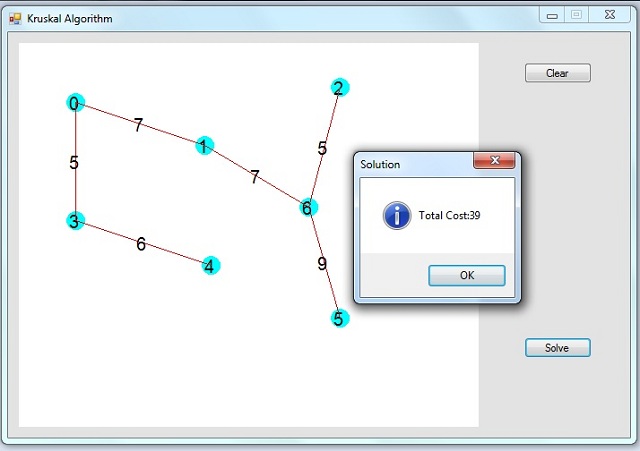Kruskal Algorithm


Introduction
According to Wikipedia:"Kruskal's algorithm is an algorithm in graph theory that finds a minimum spanning tree for a connected weighted graph. This means it finds a subset of the edges that forms a tree that includes every vertex, where the total weight of all the edges in the tree is minimized. If the graph is not connected, then it finds a minimum spanning forest (a minimum spanning tree for each connected component). Kruskal's algorithm is an example of a greedy algorithm."
In short, Kruskal algorithm is used to connect all nodes in a graph, using the least cost possible.
Example:
An internet Cafe is connecting all PC's via network.
Using the Demo
Click anywhere to plot the vertices
Hold down ctrl and select two vertices to create edge
A popup window appears to enter edge cost
Having finished plotting the graph, click Solve
Algorithm Break Down

Tricky Part:joining vertices
Besides the vertices and the edges, we have another two lists, m_lstParents and m_lstRanks, we need those to join vertices later.
Parents:Initially every vertex is its own Parent.
Ranks:Initially every vertex has rank zero.
private void MakeSet()
{
m_lstParent = new List<int>(m_lstVertices.Count);
m_lstRank = new List<int>(m_lstVertices.Count);
for (int i = 0; i < m_lstVertices.Count; i++)
{
m_lstParent.Add(i);
m_lstRank.Add(0);
}
}</int></int>
foreach edge there's 2 vertices, using the recursive function GetParent we'll get their root (parent).
private int GetParent(int nName)
{
if (m_lstParent[nName] != nName)// am I my own parent ? (am i the root ?)
{
m_lstParent[nName] = GetParent(m_lstParent[nName]);
}
return m_lstParent[nName];
}
if roots are not the same, we have to join the two vertices, depending on their rank
private void Join(Vertex v1, Vertex v2)
{
int v1Parent, v2Parent;
v1Parent = GetParent(v1.Name);
v2Parent = GetParent(v2.Name);
if (m_lstRank[v2Parent] < m_lstRank[v1Parent])//is the rank of vertex2 parent less than that of vertex1 ?
{
m_lstParent[v2Parent] = v1Parent;//yes! then vertex1 is the parent of vertex2 (since he has the higher rank)
}
else //rank of vertex2 is greater than or equal to that of vertex1
{
m_lstParent[v1Parent] = v2Parent;//make vertex 2 the parent
if (m_lstRank[v1Parent] == m_lstRank[v2Parent])//both ranks are equal ?
{
m_lstRank[v2Parent]++;//increment one of them, we need to reach a single root for the whole tree
}
}
}
Conclusion
Hope this helped to understand the algorithm clearly, If you have any questions, feel free to ask.
发表评论
obYIuc Thanks so much for the blog post.Much thanks again. Keep writing.